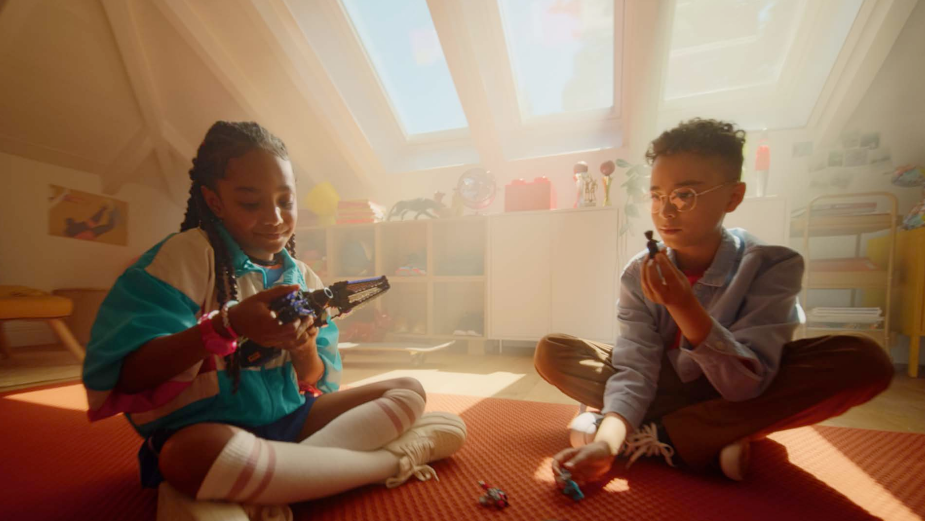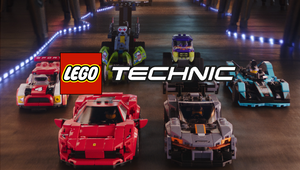
The Collaboration Behind LEGO’s ‘Wakanda Forever’ Ad

The live action / animation combination job is one that keeps the work of each specialist director, for the most part, separate from the other. While the live-action director pitches on and wins the job – selling in not only how they see the live-action sections but also their vision for the animated parts as well – they need to be confident in handing over creative control to the animators when the time comes, who’ll take that director’s concept and translate it into what we see on screen.
Here, live-action director Wes Walker (whose client portfolio includes Google, BMW, Gatorade, Nike and The LEGO Group) and company director and animation lead for Future Power Station Yibi Hu (AXE, Sex Education, Jorja Smith, Adidas, Honda) talk about how this relationship works, and how they found the dynamic worked on their collaboration for The LEGO Group x Marvel’s spot, produced by Highly Unlikely, to coincide with the launch of ‘Black Panther: Wakanda Forever’.
LBB> When the creative brief includes a combination of live action and animation, what are your initial thoughts on how these two mediums will work together?
Wes> As a director you need to see every challenge as an opportunity. Animation was a new frontier for me on this job, but I found it to be unexpectedly similar to live action – actually with even more freedom of inventiveness in camera movement and environment.
I approached it with the same core storytelling principles and questions that I always have in mind - what is our story moment by moment, how do we communicate it elegantly and succinctly, and how do we transition thoughtfully between live action and animation, so it all feels seamless?
LBB> How do you generally feel about working with a director from a different medium on the project? How do you keep your own creative voice?
Yibi> I’m used to being collaborative on any project that comes in, but I’d say it is more interesting when live-action directors want to offer different perspectives to the animators. I appreciated the creative voice we were given on this project from Wes. That bit of freedom allows the animation team to focus more on how to do the best job with their skills rather than spending too much time trying to decipher exactly what the live-action director is picturing and not going against it.
First of all, Wes’ direction is the direction of the project. We’re there to develop his vision from the animator’s point of view. What we offer is an understanding of how the look, timing, and pace need to be executed, and the full potential within those areas, to then go well with the live action. Our animation is a part of the film rather than a stand-alone piece.
LBB> Wes, what was it about Yibi and FPS’s work that caught your eye and made you want them on board?
Wes> Yibi is a master of his craft and FPS is an established powerhouse. We searched far and wide for an animation partner that could create a futuristic anime aesthetic that felt unique and beautiful - Future Power Station was the perfect partner. I've followed their work, and so many of the animation-to-live-action films that I love were made by them.
A simple glance at the Future Power Station website reveals clear differentiations in style from film to film, which tells me that they’ve really absorbed the story and specific needs of each of the briefs they’ve been given before choosing a visual language that matches.
LBB> What have you found to be the keys to success on this LEGO Black Panther job?
Wes> A big key is always going to be communication, and to be specific, visual communication. References are everything and they should be from anywhere and everywhere. For example, I've always loved how the sun during two specific times of year pierces through the buildings in NYC, it's often called 'Manhattanhenge' and I sent a photo of this to Yibi and FPS as a way of animating the Sunbird flying through Wakanda. It felt epic, beautiful, and fun.
Yibi> Directors are all different from each other, but Wes was accessible and collaborative which made everything easier. We had a great time chatting through the ideas and being very clear of the live-action direction. It is always quite a job when directors try to make their vision clear and present it in a visual way.
We respected Wes’ vision on the project. He sold us on what he was wanting to achieve. We were there to support Wes in further actualising the sequence. In return, he really respected our expertise and expected creative sparks from us, which is a pleasure to work with. I would call this a true professional relationship.

LBB> What are your feelings on getting to work on a spot related to Marvel’s ‘Black Panther’ franchise? Do these jobs feel more important because of the cultural narrative around them or is every job just that – a job?
Wes> Working on the Black Panther franchise was a dream. It's imperative that the work I do has meaning, even if only for me. I don't take on projects I don't have a heart-centred connection to. Core to my work as an Afro-Latino director is uplifting the narratives and humanity of all people of colour – we deserve to be seen, heard, felt, and respected.
LBB> Building on that, where do you think the advertising industry is on representative diversity, particularly in the filmmaking space? And what sort of decisions would you like to see more of to improve on this? Are there practises you put into place in your work that you would like to see being the norm across every set and shoot, regardless of the subject matter or identity of the director?
Wes> Huge improvements have been made industry-wide, but we have a massively long way to go. Performative virtue signalling is still rampant even post Black Lives Matter; but doing the work of unearthing bias and racism across organisations and ensuring that equal representation happens in front of and behind the lens is not easy.
Personally, I approach this from the top – as a director, I have a strong say in who is hired on my sets and I always aim to hire and follow-up with my teams to ensure that my sets are demographically representative. I’ve also begun to offer director shadowing on all my films to young, up-and-coming directors of colour who benefit greatly by seeing my entire process from treatment through to post-production as well as getting introduced to my crew and collaborators.
It's important that we open doors for each other. “Each one, teach one” as my dad would always tell me growing up.









